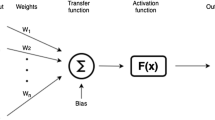Abstract
To address the detection difficulty problem of unmanned aerial vehicles (UAVs) in complex electromagnetic environments, this paper proposes a genetic algorithm-based heterogeneous integrated k-nearest neighbor (KNN) model for UAV signal recognition. First, the original data is pre-processed by discrete Fourier transform (DFT). Next, the genetic algorithm is deployed to find feature points for each base classifier to be integrated into the high-density power spectrum. Following this, each base classifier to be integrated is set into a strong classifier, and finally, the data to be detected is transferred to the trained integrated classifier to get the UAV signal detection results. The experimental results show that the genetic algorithm bagging KNN (GA-Bagging-KNN) algorithm achieves 98% accuracy in detecting binary classification and 79% accuracy in quadruple classification.







Similar content being viewed by others
References
Martian, A., et al. (2021). RF based UAV detection and defense systems: Survey and a novel solution. In 2021 IEEE international black sea conference on communications and networking (BlackSeaCom). IEEE, 2021.
Zhang, Y., et al. (2021). Visual image and radio signal fusion identification based on convolutional neural networks. Journal of Optics, 50, 237–244.
Wang, L., & Cavallaro, A. (2022). Deep-learning-assisted sound source localization from a flying drone. IEEE Sensors Journal, 22(21), 20828–20838.
Shi, X., Fang, C., et al. (2018). Anti-drone system with multiple surveillance technologies: Architecture, implementation, and challenges. IEEE Communications Magazine, 56(4), 68–74.
Reising, D. R., Temple, M. A., & Jackson, J. A. (2015). Authorized and rogue device discrimination using dimensionally reduced RF-DNA fingerprints. IEEE Transactions on Information Forensics and Security, 10(6), 1180–1192.
Lukacs, M., Collins, P., & Temple, M. (2015). Classification performance using “RF-DNA” fingerprinting of ultra-wideband noise waveforms. Electronics Letters, 51(10), 787–789.
Sazdić-Jotić, B., et al. (2022). Single and multiple drones detection and identification using RF based deep learning algorithm. Expert Systems with Applications, 187, 115928.
Niu, R., Qu, Y., & Wang, Z. (2021). UAV Detection Based on Improved YOLOv4 Object Detection Model. In 2021 2nd international conference on big data & artificial intelligence & software engineering (ICBASE), Sep. 2021, (pp. 25–29). https://doi.org/10.1109/ICBASE53849.2021.00012
Dong, Q., & Zou, Q. (2017). Visual UAV detection method with online feature classification. In 2017 IEEE 2nd information technology, networking, electronic and automation control conference (ITNEC), Dec. 2017, pp. 429–432. https://doi.org/10.1109/ITNEC.2017.8284767
Zhang, X., & Huang, D. (2013). Research on UAV ground target detection based on improved YOLOv7. In 2023 3rd International Conference on Computer, Control and Robotics (ICCCR), Mar. 2023 (pp. 28–32). https://doi.org/10.1109/ICCCR56747.2023.10193961
Shao, S., Zhu, W., & Li, Y. (2022). Radar detection of low-slow-small UAVs in complex environments. In 2022 IEEE 10th joint international information technology and artificial intelligence conference (ITAIC), Jun. 2022 (pp. 1153–1157). https://doi.org/10.1109/ITAIC54216.2022.9836542.
Nie, W., et al. (2022). UAV detection and localization based on multi-dimensional signal features. IEEE Sensors Journal, 22(6), 5150–5162. https://doi.org/10.1109/JSEN.2021.3105229
Xie, Y., Jiang, P., Gu, Y., & Xiao, X. (2021). Dual-source detection and identification system based on UAV radio frequency signal. IEEE Transactions on Instrumentation and Measurement, 70, 1–15. https://doi.org/10.1109/TIM.2021.3103565
Kaushik, S.M, et al. (2022). Entropy based detection approach for Micro-UAV and classification using machine learning. In 2022 third international conference on intelligent computing instrumentation and control technologies (ICICICT). IEEE (2022).
Zhang, W., & Li, G. (2018). Detection of multiple micro-drones via cadence velocity diagram analysis. Electronics Letters, 54(7), 441–443.
Fuhrmann, L., Biallawons, O., Klare, J., Panhuber, R., Klenke, R., & Ender, J. (2017). 'Micro-Doppler analysis and classification of UAVs at Ka band. In: Proceedings of the IEEE 18th International Radar Symposium (IRS), Jun. 2017 (pp. 1–9).
Molchanov, P., Harmanny, R. I. A., de Wit, J. J. M., Egiazarian, K., & Astola, J. (2014). ’Classification of small UAVs and birds by micro-Doppler signatures. International Journal of Microwave and Wireless Technologies, 63(4), 435–444.
Zhang, P., Yang, L., Chen, G., & Li, G. (2017). Classification of drones based on micro-Doppler signatures with dual-band radar sensors. In Proceedings of the Progress in Electromagnetics Research Symposium-Fall (PIERS - FALL) Nov. 2017 (pp. 638–643).
Jahangir, M., & Baker, C. (2016). 'Robust detection of micro-UAS drones with L-band 3-D holographic radar. In Proceedings of the IEEE Sensor Signal Processing for Defence (SSPD), Sep. 2016 (pp. 1–5).
Ritchie, M., Fioranelli, F., Borrion, H., & Griffiths, H. (2017). Multistatic micro-Doppler radar feature extraction for classification of unloaded/loaded micro-drones. IET Radar, Sonar & Navigation, 11(1), 116–124.
Ma, J., et al. (2017). Small object detection with random decision forests. In 2017 IEEE International Conference on Unmanned Systems (ICUS). IEEE, (2017).
Zuo, M., et al. (2021). Recognition of UAV video signal using RF fingerprints in the presence of WiFi interference. IEEE Access, 9, 88844–88851.
Al-Sad, M. F., et al. (2019). "RF-based drone detection and identification using deep learning approaches: An initiative towards a large open source drone database. Future Generation Computer Systems, 100, 86–89.
Sobey, A. J., & Grudniewski, P. A. (2018). Re-inspiring the genetic algorithm with multi-level selection theory: multi-level selection genetic algorithm. Bioinspiration & Biomimetics, 13(5), 056007.
Hu, J., et al. (2021). Protein-DNA binding residue prediction via bagging strategy and sequence-based cube-format feature. IEEE/ACM Transactions on Computational Biology and Bioinformatics, 19(6), 3635–3645.
Author information
Authors and Affiliations
Contributions
YX: writing-original draft, validation, formal analysis, software, methodology, investigation, data curation, YC: validation, YZ: validation, JS: formal analysis, ZJ: validation, HL: validation, YP: methodology, writing-review and editing, resources, supervision, JZ: methodology, writing-review and editing, resources, supervision, project administration
Corresponding authors
Ethics declarations
Competing interests
The authors declare no competing interests.
Additional information
Publisher's Note
Springer Nature remains neutral with regard to jurisdictional claims in published maps and institutional affiliations.
Rights and permissions
Springer Nature or its licensor (e.g. a society or other partner) holds exclusive rights to this article under a publishing agreement with the author(s) or other rightsholder(s); author self-archiving of the accepted manuscript version of this article is solely governed by the terms of such publishing agreement and applicable law.
About this article
Cite this article
Xue, Y., Chang, Y., Zhang, Y. et al. UAV signal recognition of heterogeneous integrated KNN based on genetic algorithm. Telecommun Syst 85, 591–599 (2024). https://doi.org/10.1007/s11235-023-01099-x
Accepted:
Published:
Issue Date:
DOI: https://doi.org/10.1007/s11235-023-01099-x




